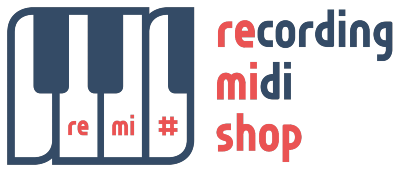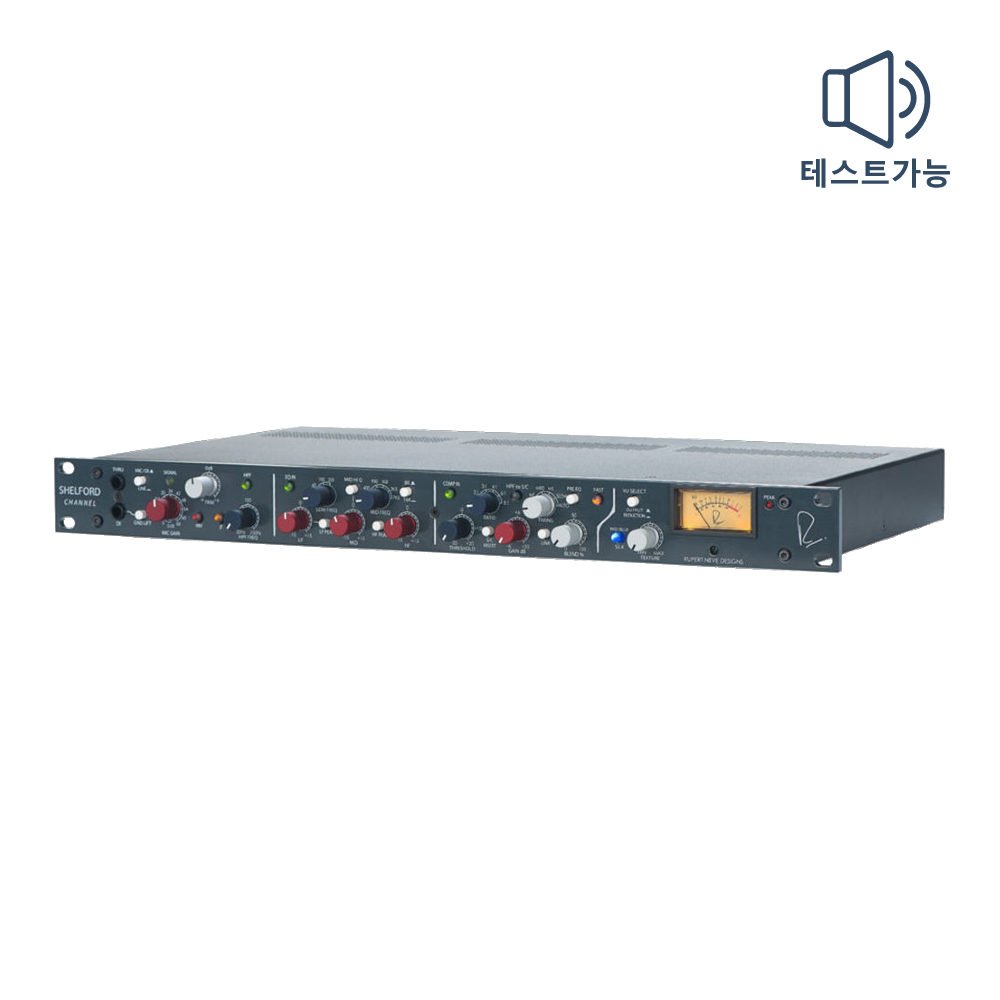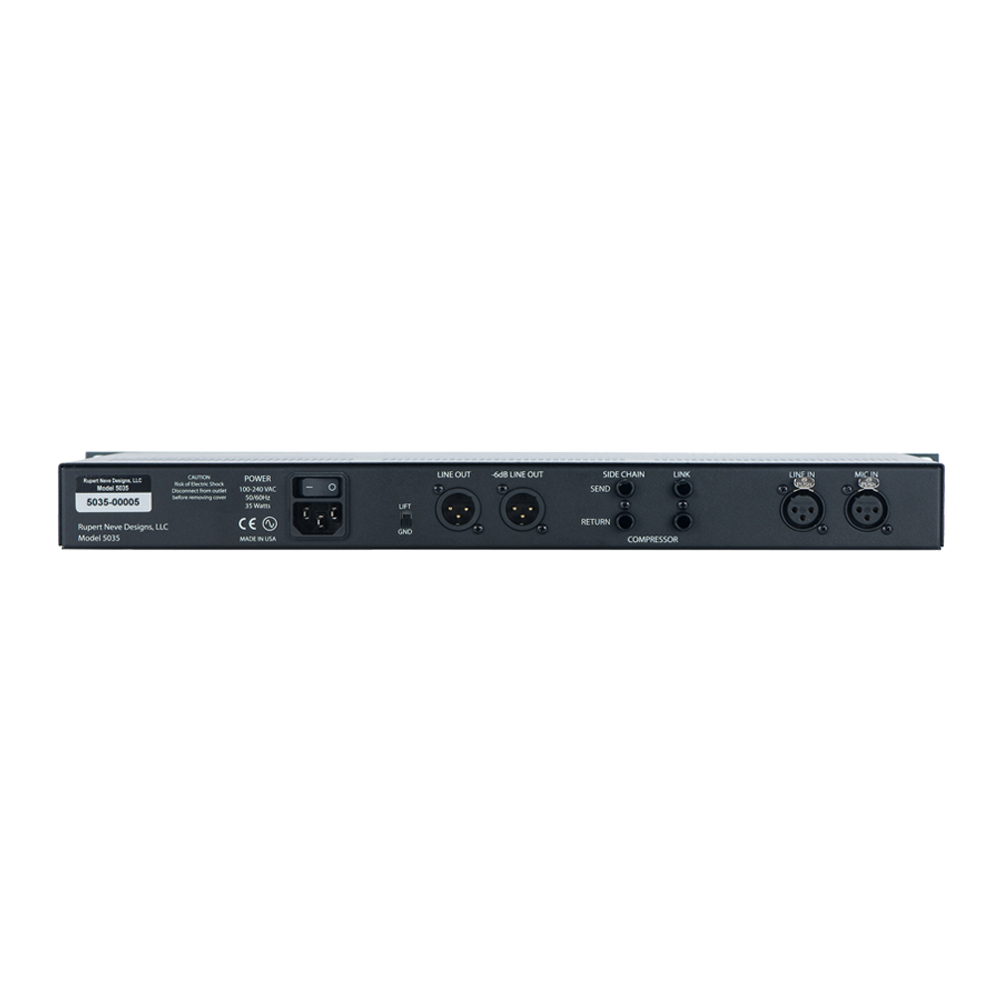SHELFORD CHANNEL
Mic Pre + Inductor EQ + Compressor
FEATURES
Silk / Texture
Pushing the Silk button cycles the Silk modes from Red to Blue to OFF. Silk reduces the negative feedback on the output transformer, adding harmonic content as the texture is increased. Red Silk accentuates the musical harmonic saturation from the mid and high frequencies, while Blue Silk accentuates harmonics from the low and low-mid frequencies. By manipulating the Texture control, the amount of Silk can be changed from essentially absent, to roughly 4-5% THD (mostly second order) depending on how hard the output transformer is being driven.
DI / THRU
The Hi-Z front panel input uses the same discrete class-A FET with transformer topology as the Rupert Neve Designs RNDI, but it utilizes the new RN4012 input transformer directly into the microphone preamp for gain. This design, delivers exceptional clarity to high-Z sources, with a substantial low-end presence and incredibly smooth high frequencies. The DI also includes a passive THRU output to feed a separate amplifier.
MIC/DI & LINE
Switches between microphone/direct injection input (button out) or line input (button in).
Gnd Lift
This switch separates the direct connection from audio signal ground to chassis earth.
Signal Present LED
This LED is dual function. When green, it indicates “Signal Presence” (a signal level of -20dBu). When red, it indicates 2-3dB below input stage clipping of the Mic/Line stage (+23 dBu while the pre actually clips at +25 dBu).
Mic Gain
This 12-way precision rotary switch controls gain from 0 to 66 dB in 6 dB steps.
Trim
This rotary switch provides further continuous gain adjustment over a range of +/– 6 dB.
48V
This push button switch engages phantom power on the microphone input.
Polarity
This push button switch inverts the polarity of the signal path. It illuminates when engaged. (The symbol “Ø” is often used to denote opposite polarity.)
HPF / HPF FREQ
The HPF switch engages a 12dB per octave high pass filter. The HPF FREQ potentiometer is variable from 20Hz to 250Hz, and can be used to filter out unwanted low frequencies, or in conjunction with the EQ to help shape source material. Note that engaging the HPF to S/C switch moves the HPF from the primary signal path to the compressor side-chain signal path.
EQ In
This switch engages all EQ frequency bands except the HPF.
LF EQ
+/- 15dB, Shelf or Peak, selectable at 35 Hz, 60 Hz, 100 Hz or 220 Hz.
MID EQ
+/- 15dB with 6 center frequencies; 220 Hz, 400 Hz, 900 Hz, 1.8 kHz, 3.5 kHz and 7.5 kHz, with MID HI Q switch to narrow the bandwidth or increase the Q of the filter.
HF EQ
+/- 15dB, Shelf or Peak, selectable at 8 kHz or 16 kHz.
Comp In
The compressor-limiter section is engaged with this button in.
Threshold
Sets level where the compressor may begin to react, from -25 dB to +20 dB. Minimal or no compression is with this control fully clockwise and it gets more sensitive and tends to cause more gain reduction as the knob is rotated counter-clockwise.
Ratio
Sets the “slope” of the compression from 1.5:1 (minimal) to 8:1 (significant).
SC (Side Chain) Insert
When engaged, this inserts an external device into the side-chain signal path via the rear panel side-chain insert jacks. These pairs of jacks are used to perform some fine-tuning of the compressor operation. The audio that normally controls the compressor is available on the “SIDE CHAIN SEND” jack. One can take this audio and pass it through an external equalizer then return it back to the “SIDE CHAIN RETURN” jack, so changes on the external EQ affect the response of the compressor.
HPF to S/C
This routes the High Pass Filter into the side chain of the compressor circuit.
Gain
Applies post-compressor make-up gain.
Timing
This six-position controls adjusts the attack/release speed of the compressor. For specific timing values, see Specifications below, or reference the manual.
Link
Links the side-chain control of multiple units for ganged operation, such as would be used in stereo compression.
Pre EQ
Pushing this button places the Compressor before the EQ in the circuit.
Blend
This controls the mixture of the dry, uncompressed signal with the compressed signal. Fully counter-clockwise is uncompressed, and is very similar to not having the “COMP IN” button pushed in. Fully clockwise is 100% compressor-limiter path.
Fast
When pressed, speeds up both the attack and release of the compressor’s selected time constant.
VU Meter
The VU Meter is calibrated to display both average (RMS) output level and compressor gain reduction
Peak LED
Red indicates near clipping of the output stage.
Dual Tap Output
In addition to the MAIN full-headroom output, the -6dB output creates a rich harmonic character while reducing the risk of clipping the next device in the chain.
Universal IEC Power Input
Works worldwide, accepting voltages from 100-240VAC.
Spec.
MIC PREAMP
INPUT IMPEDANCE
2200 Ohm
MAXIMUM INPUT
+21.5 dBu from 150 Hz to 22 kHz
+8 dBu 20 Hz to 22 kHz
NOISE
Un-weighted, 22 Hz-22 kHz, source impedance 150 Ohm balanced.
Main Out @ unity gain -100.9 dBu
-6 dB Out @ unity gain -106.6 dBu
+30 dB gain (Main Out) -91.37 dBu
+66 dB Gain (Main Out) -64.1 dBu
Equivalent Input Noise -121.37 dBu
FREQUENCY RESPONSE
+/-0.25 dB from 17 Hz to 45 kHz
DIRECT INPUT
MAXIMUM INPUT
8 dBu @ 20 Hz to 120 kHz
NOISE (MAIN OUTPUT)
-100 dBu (22 Hz to 22 kHz)
LINE INPUT
MAXIMUM INPUT LEVEL
+30.5 dBu 20 Hz to 30 kHz
TOTAL HARMONIC DISTORTION AND NOISE
@ 1 kHz, +20 dBu output level, no load: Better than 0.002%
@ 20 Hz, +20 dBu output level, no load: 0.05% Typical (2nd and 3rd harmonic)
NOISE (MAIN OUTPUT)
Un-weighted, 22 Hz - 22 kHz, source impedance 40 Ohm balanced, no load.
-101.1 dBu
FREQUENCY RESPONSE
+/- 0.25 dBu from less than 10 Hz to 110 kHz
-0.32 dB @ 120 kHz
MAXIMUM OUTPUT LEVEL
+26 dBu @ 16 Hz to 20 kHz
TOTAL HARMONIC DISTORTION AND NOISE WITH SILK ENGAGED
RED
MIN TEXTURE @ 100 Hz, +20 dBu input level, no load: 0.0131%, mostly 3rd harmonic (typical)
MAX TEXTURE @ 100 Hz, +20 dBu input level, no load: 1.66%, mostly 2rd harmonic (typical)
BLUE
MIN TEXTURE @ 100Hz, +20 dBu input level, no load: 0.0079%, mostly 3rd harmonic (typical)
MAX TEXTURE @ 100Hz, +20 dBu input level, no load: 0.941%, mostly 2rd harmonic (typical)
HIGH PASS FILTER
Continuously variable swept frequency from 20 Hz to 250 Hz.
Slope: 12 dB/Octave
EQ NOISE
Un-weighted, 22 Hz-22 kHz: -92 dBu
SIGNAL PRESENT
Illuminates GREEN when input stage signal level reaches -20 dBu
OVERLOAD INDICATOR
Illuminates RED when input stage signal level reaches -23 dBu
DIODE BRIDGE COMPRESSOR
NOISE (BW 22 Hz – 22 kHz)
0 dB Makeup Gain: -84.5 dBu
+20 dB Makeup Gain: -64.2 dBu
TIME CONSTANTS
Measurements taken represent full range achievable between 1.5:1 Ratio and 8:1 Ratio setting.
0 dBu I/P 1kHz Burst Tone used for all recorded measurements.
Fast (TC1): Attack 180µS — 1.8mS // Release 100mS – 150mS
MedFast (TC2): Attack 750µS – 5.25mS // Release 160mS – 250mS
Med (TC3): 2.7mS – 18mS // Release 350mS – 525mS
MedSlow (TC4): 4.6mS – 38mS // Release 600mS – 1 S
Slow (TC5): 11mS – 72.5mS // Release 800mS – 1.25 S
Auto (TC6): 5.75mS – 35.5mS // Release T1 400mS – 850mS, T2 TBD
“Fast” Mode Multiplier: Modifies aforementioned TC’s by 70% of original value







